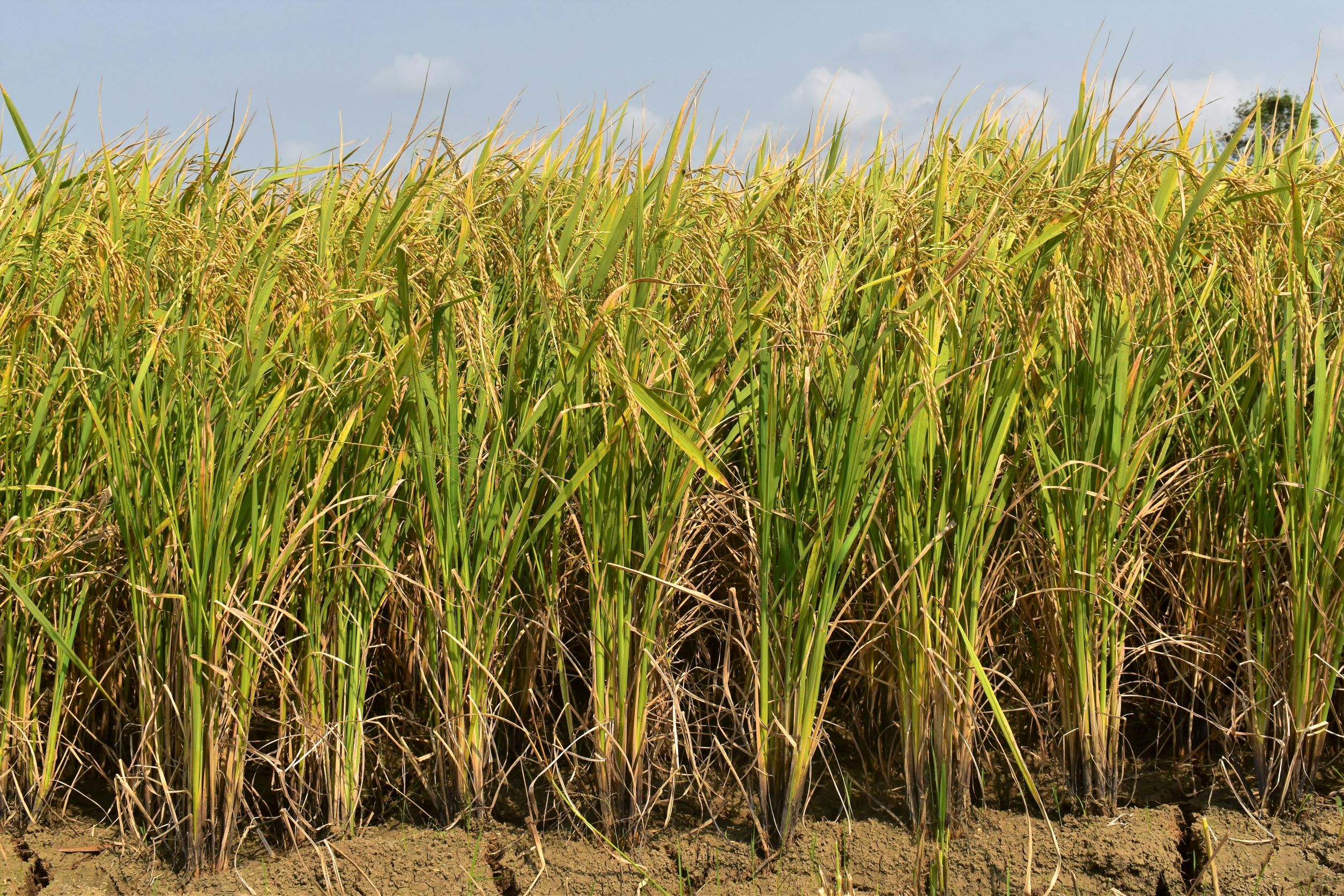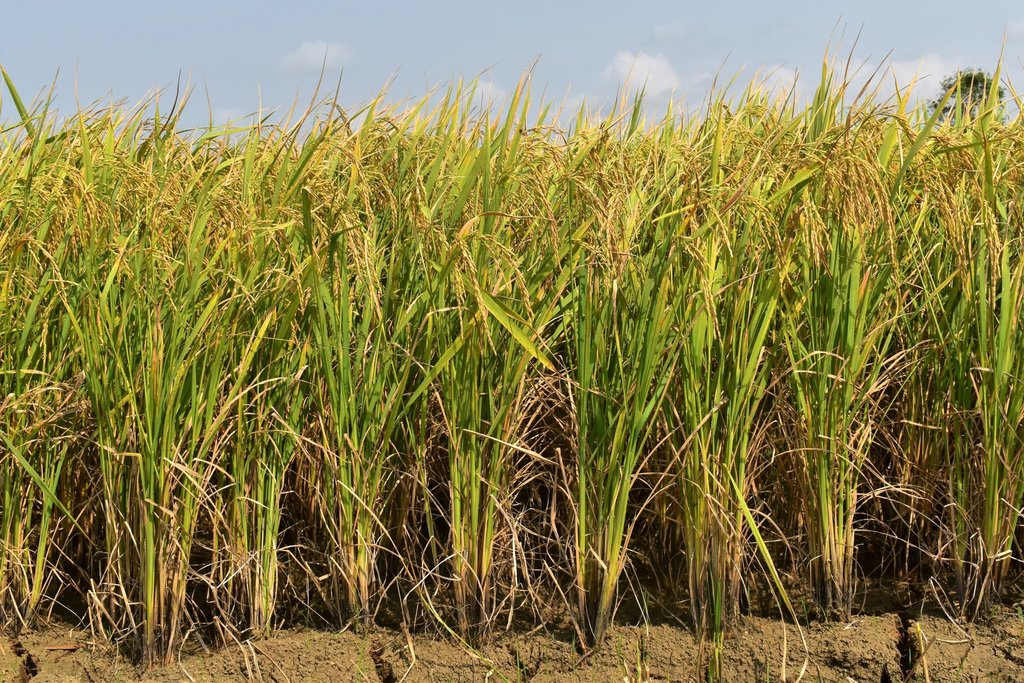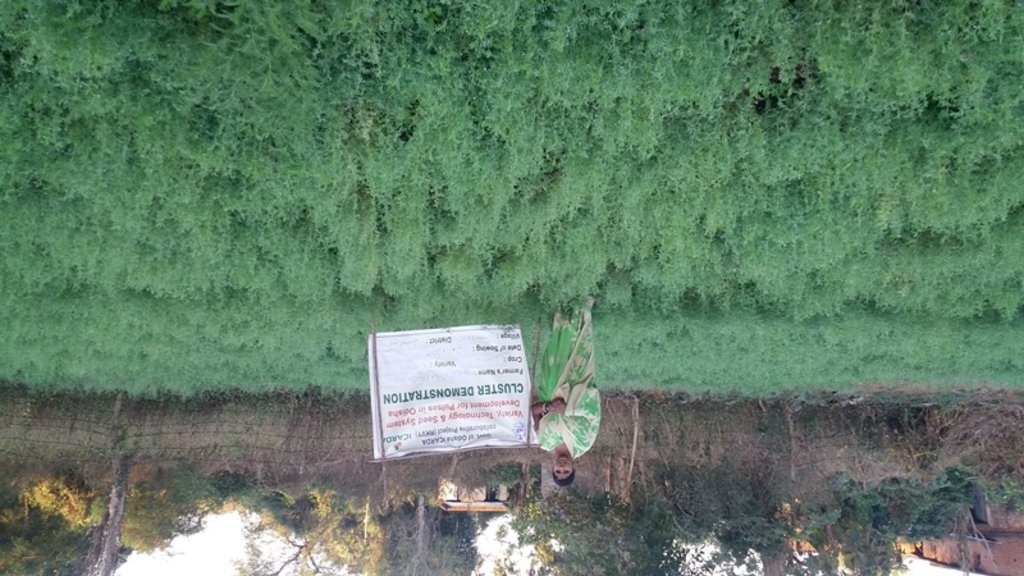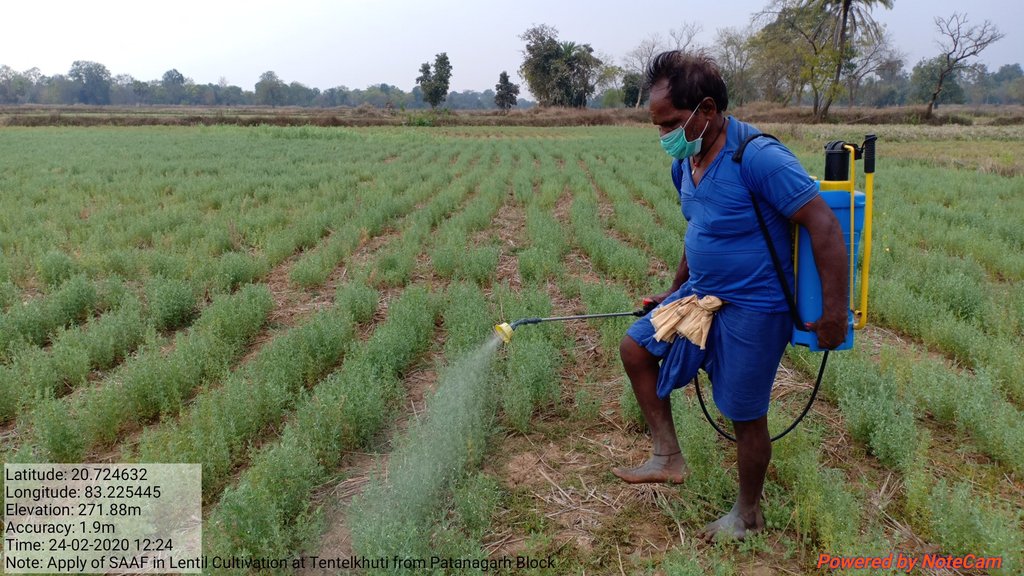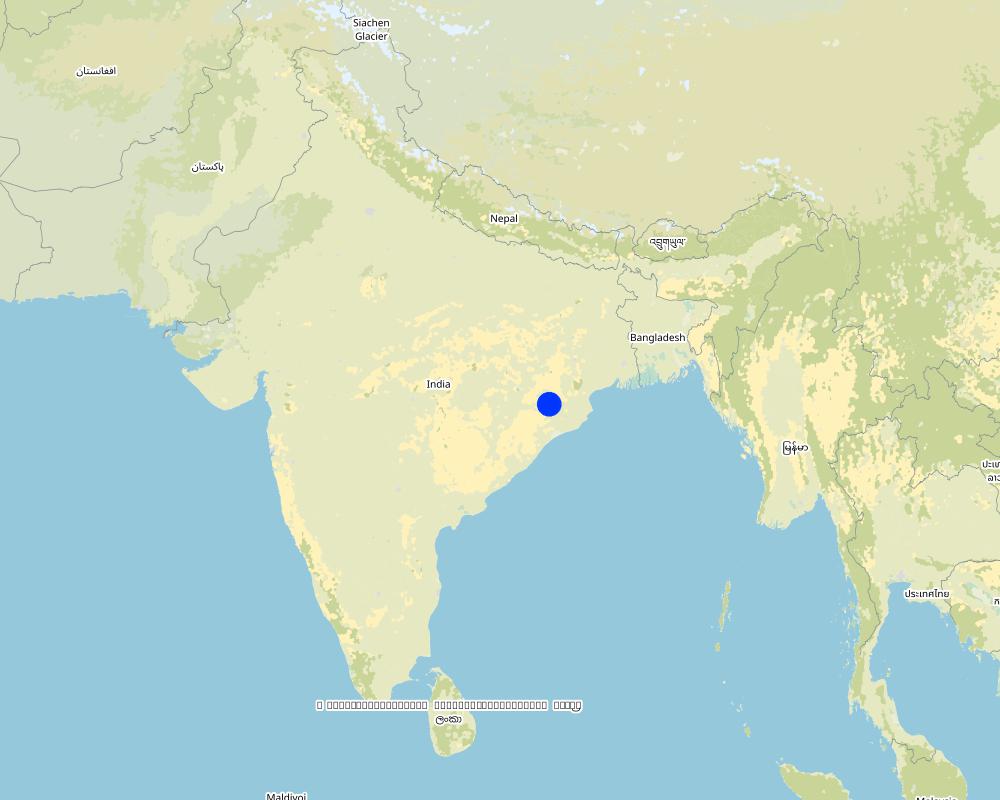Legumes in rice-based cropping systems [India]
- Creation:
- Update:
- Compiler: Joren Verbist
- Editor: –
- Reviewers: William Critchley, Rima Mekdaschi Studer
technologies_6489 - India
View sections
Expand all Collapse all1. General information
1.2 Contact details of resource persons and institutions involved in the assessment and documentation of the Technology
Key resource person(s)
Agricultural Economist:
Swain Nigamananda
International Center of Agriculture Research in the Dry Areas (ICARDA)
India
Lentil Breeder:
Reena Mehra
International Center of Agriculture Research in the Dry Areas (ICARDA)
India
Name of project which facilitated the documentation/ evaluation of the Technology (if relevant)
ICARDA Institutional Knowledge Management Initiative {'additional_translations': {}, 'value': 1140, 'label': 'Name of the institution(s) which facilitated the documentation/ evaluation of the Technology (if relevant)', 'text': 'International Center for Agricultural Research in the Dry Areas (ICARDA) - Lebanon', 'template': 'raw'}1.3 Conditions regarding the use of data documented through WOCAT
The compiler and key resource person(s) accept the conditions regarding the use of data documented through WOCAT:
Yes
1.4 Declaration on sustainability of the described Technology
Is the Technology described here problematic with regard to land degradation, so that it cannot be declared a sustainable land management technology?
No
2. Description of the SLM Technology
2.1 Short description of the Technology
Definition of the Technology:
In India, 29 percent of the area cropped with rice remains fallow during the dry "rabi" season. This offers the opportunity to improve farm income and soil health by introducing legumes especially lentils. Diversifying the cropping system in such a way results in higher farm income due to additional crop produce and reduced carbon and water footprints.
2.2 Detailed description of the Technology
Description:
In India, monsoon-season “kharif” rice is usually grown between June and November, while in the dry winter “rabi” season (from November to February), farmers keep these lands fallow due to lack of irrigation. Another constraint is a suitable crop with available seed for such a short window. Given the World Health Organization’s recommended pulse (legume grain) consumption of 50 g per capita per day, Odisha state needs to produce more. Here, legumes are grown on approximately 2.1 million hectares and total pulse production is 1.06 million tonnes. This results in an annual deficit of 0.22 million tonnes of pulses and a per capita per day consumption of only 11-23 grams. Odisha is exploring the vast potential for fallow cultivation of legumes.
The International Center for Agricultural Research in the Dry Areas (ICARDA) recognised this challenge and tested the introduction of lentils during the fallow rabi period. This resulted in a diversified cropping system as demonstrated in the following case study from the interior of Odisha, which is hilly with a cool winter season. Rice is the most commonly cultivated crop. The climate (1000-1500 mm of annual rainfall) and loamy-silty soil is suitable for lentils (Lens culinaris) - especially short duration varieties that can grow residual moisture of the rice.
During the 2018-2021 seasons, the lentil-rice cropping system was demonstrated on 165 ha of farmers’ fields involving 1920 farmers. The average yield of lentils was 790 kg/ha which generates traditional net-farm income of around 200 USD/hectare. Lentils have proved to have good potential: rice yields are not reduced and hence, from a cost-benefits perspective, it is a very viable option. Therefore, the state government is now promoting lentils as a fallow crop in rice-based systems in hilly areas with a cool winter season.
Lentil cultivation is as follows. Firstly, lentils are seeded (40 kg/ha) in the second week of November at a spacing of 30 x 5 cm. 3.5 kilogram of biocides (fungicides, herbicides, and pesticides) per ha are required and 50 kilogram of NPK fertilizer per ha is applied. Manual weeding takes around 20 person-days per ha. The lentils are harvested in February, requiring around 15 person-days per ha. Family labour provides for just over half of the field operations and a quarter of the harvest.
To conclude, growing lentils in the fallow period of rice-based cropping systems offers an opportunity to formulate a more climate resilient cropping system that improves soil health and farm income. This also has positive impact on health due to the inclusion of more pulses in the diet.
Data presented is from the bilateral project on pulses development funded by the Department of Agriculture & Farmers Empowerment, Government of Odisha with financial support from RKVY during 2018-2021 and implemented in collaboration with ICARDA. The work acknowledges the contribution of all scientists and team members in the ICARDA India programme: in the field and at headquarters.
2.3 Photos of the Technology
2.5 Country/ region/ locations where the Technology has been applied and which are covered by this assessment
Country:
India
Region/ State/ Province:
Odisha
Specify the spread of the Technology:
- evenly spread over an area
If precise area is not known, indicate approximate area covered:
- 1-10 km2
Is/are the technology site(s) located in a permanently protected area?
No
Map
×2.6 Date of implementation
Indicate year of implementation:
2018
2.7 Introduction of the Technology
Specify how the Technology was introduced:
- during experiments/ research
- through projects/ external interventions
3. Classification of the SLM Technology
3.1 Main purpose(s) of the Technology
- improve production
- reduce, prevent, restore land degradation
- adapt to climate change/ extremes and its impacts
- create beneficial economic impact
- create beneficial social impact
3.2 Current land use type(s) where the Technology is applied
Land use mixed within the same land unit:
No

Cropland
- Annual cropping
Annual cropping - Specify crops:
- cereals - rice (wetland)
- legumes and pulses - lentils
Number of growing seasons per year:
- 2
Is intercropping practiced?
No
Is crop rotation practiced?
Yes
If yes, specify:
Rice: July- November;
Lentil: Nov-February
3.3 Has land use changed due to the implementation of the Technology?
Has land use changed due to the implementation of the Technology?
- No (Continue with question 3.4)

Cropland
- Annual cropping
Annual cropping - Specify crops:
- cereals - rice (wetland)
3.4 Water supply
Water supply for the land on which the Technology is applied:
- mixed rainfed-irrigated
3.5 SLM group to which the Technology belongs
- rotational systems (crop rotation, fallows, shifting cultivation)
- improved ground/ vegetation cover
- improved plant varieties/ animal breeds
3.6 SLM measures comprising the Technology

agronomic measures
- A1: Vegetation/ soil cover
- A5: Seed management, improved varieties
- A6: Residue management
3.7 Main types of land degradation addressed by the Technology

chemical soil deterioration
- Cn: fertility decline and reduced organic matter content (not caused by erosion)

biological degradation
- Bc: reduction of vegetation cover
- Bq: quantity/ biomass decline
3.8 Prevention, reduction, or restoration of land degradation
Specify the goal of the Technology with regard to land degradation:
- prevent land degradation
- reduce land degradation
4. Technical specifications, implementation activities, inputs, and costs
4.1 Technical drawing of the Technology
Technical specifications (related to technical drawing):
Lentil:
The plant to plant distance within a row (A) = 10 centimeters
The row to row distance (B) = 30 centimeters
Author:
Reena Mehra
Date:
2022
Technical specifications (related to technical drawing):
Rice:
The plant to plant distance within a row (A) = 15 centimeters
The row to row distance (B) = 15 centimeters
Author:
Reena Mehra
Date:
2022
4.2 General information regarding the calculation of inputs and costs
Specify how costs and inputs were calculated:
- per Technology area
Indicate size and area unit:
1 hectare of lentil cultivation
other/ national currency (specify):
Indian rupee
If relevant, indicate exchange rate from USD to local currency (e.g. 1 USD = 79.9 Brazilian Real): 1 USD =:
80.0
4.5 Maintenance/ recurrent activities
| Activity | Timing/ frequency | |
|---|---|---|
| 1. | Lentil: Seeding | Second week November |
| 2. | Lentil: Fungicide | First week January |
| 3. | Lentil: Herbicide | Second week December |
| 4. | Lentil: Fertilizer | January |
| 5. | Lentil: Weeding | |
| 6. | Lentil: Harvest | February |
| 7. | Rice: Seeding | First week of June |
| 8. | Rice: Irrigation | June |
| 9. | Rice: Fertilizer 1 | Directly after seeding |
| 10. | Rice: Fertilizer 2 | 15 days after seeding |
| 11. | Rice: Fertilizer 3 | 90 days after seeding |
| 12. | Rice: Weeding | |
| 13. | Rice: Harvest | November |
4.6 Costs and inputs needed for maintenance/ recurrent activities (per year)
| Specify input | Unit | Quantity | Costs per Unit | Total costs per input | % of costs borne by land users | |
|---|---|---|---|---|---|---|
| Labour | Lentil: Weeding | Person-hour | 20.0 | 300.0 | 6000.0 | |
| Labour | Lentil: Harvest | Person-hour | 15.0 | 300.0 | 4500.0 | |
| Labour | Rice: Weeding | Person-hour | 6.0 | 300.0 | 1800.0 | |
| Labour | Rice: Harvest | Person-hour | 15.0 | 300.0 | 4500.0 | |
| Equipment | Lentil: Zero-Seeder | Machine-hour | 2.5 | 1200.0 | 3000.0 | |
| Equipment | Lentil: Sprayer | Machine-hour | 1.0 | 300.0 | 300.0 | |
| Equipment | Rice: Tractor for land preparation | Machine-hour | 1.0 | 1200.0 | 1200.0 | |
| Equipment | Rice: Tractor for transplantation | Machine-hour | 5.0 | 1200.0 | 6000.0 | |
| Plant material | Lentil: Seed | Kilogram | 45.0 | 105.0 | 4725.0 | |
| Plant material | Rice: Seed | Kilogram | 25.0 | 30.0 | 750.0 | |
| Fertilizers and biocides | Lentil: Fungicide | Kilogram | 0.5 | 600.0 | 300.0 | |
| Fertilizers and biocides | Lentil: Herbicide | Liter | 1.5 | 367.0 | 550.5 | |
| Fertilizers and biocides | Lentil: NPK-fertilizer | Kilogram | 0.5 | 150.0 | 75.0 | |
| Fertilizers and biocides | Rice: Gromor (first application) | Kilogram | 5.0 | 40.0 | 200.0 | |
| Fertilizers and biocides | Rice: DAP (first application) | Kilogram | 100.0 | 35.0 | 3500.0 | |
| Fertilizers and biocides | Rice: Potash (2:1 -> first and third application) | Kilogram | 90.0 | 40.0 | 3600.0 | |
| Fertilizers and biocides | Rice: Urea (2:1 -> second and third application) | Kilogram | 90.0 | 10.0 | 900.0 | |
| Other | Rice: Irrigation after seeding | Liter | 3.0 | 100.0 | 300.0 | |
| Other | Rice: Irrigation in maturity (if needed) | Liter | 10.0 | 100.0 | 1000.0 | |
| Other | Rice: Transplantation | Person-hour | 19.0 | 300.0 | 5700.0 | |
| Other | Rice: Fertilizer | Person-hour | 6.0 | 300.0 | 1800.0 | |
| Total costs for maintenance of the Technology | 50700.5 | |||||
| Total costs for maintenance of the Technology in USD | 633.76 | |||||
5. Natural and human environment
5.1 Climate
Annual rainfall
- < 250 mm
- 251-500 mm
- 501-750 mm
- 751-1,000 mm
- 1,001-1,500 mm
- 1,501-2,000 mm
- 2,001-3,000 mm
- 3,001-4,000 mm
- > 4,000 mm
Agro-climatic zone
- humid
5.2 Topography
Slopes on average:
- flat (0-2%)
- gentle (3-5%)
- moderate (6-10%)
- rolling (11-15%)
- hilly (16-30%)
- steep (31-60%)
- very steep (>60%)
Landforms:
- plateau/plains
- ridges
- mountain slopes
- hill slopes
- footslopes
- valley floors
Altitudinal zone:
- 0-100 m a.s.l.
- 101-500 m a.s.l.
- 501-1,000 m a.s.l.
- 1,001-1,500 m a.s.l.
- 1,501-2,000 m a.s.l.
- 2,001-2,500 m a.s.l.
- 2,501-3,000 m a.s.l.
- 3,001-4,000 m a.s.l.
- > 4,000 m a.s.l.
Indicate if the Technology is specifically applied in:
- not relevant
5.3 Soils
Soil depth on average:
- very shallow (0-20 cm)
- shallow (21-50 cm)
- moderately deep (51-80 cm)
- deep (81-120 cm)
- very deep (> 120 cm)
Soil texture (topsoil):
- medium (loamy, silty)
Soil texture (> 20 cm below surface):
- medium (loamy, silty)
Topsoil organic matter:
- medium (1-3%)
5.4 Water availability and quality
Ground water table:
5-50 m
Availability of surface water:
poor/ none
Water quality (untreated):
poor drinking water (treatment required)
Water quality refers to:
ground water
Is water salinity a problem?
No
Is flooding of the area occurring?
Yes
Regularity:
episodically
5.5 Biodiversity
Species diversity:
- low
Habitat diversity:
- low
5.6 Characteristics of land users applying the Technology
Sedentary or nomadic:
- Sedentary
Market orientation of production system:
- mixed (subsistence/ commercial)
Off-farm income:
- less than 10% of all income
Relative level of wealth:
- poor
Individuals or groups:
- individual/ household
Level of mechanization:
- manual work
- mechanized/ motorized
Gender:
- women
- men
Age of land users:
- middle-aged
5.7 Average area of land used by land users applying the Technology
- < 0.5 ha
- 0.5-1 ha
- 1-2 ha
- 2-5 ha
- 5-15 ha
- 15-50 ha
- 50-100 ha
- 100-500 ha
- 500-1,000 ha
- 1,000-10,000 ha
- > 10,000 ha
Is this considered small-, medium- or large-scale (referring to local context)?
- small-scale
5.8 Land ownership, land use rights, and water use rights
Land ownership:
- individual, not titled
- individual, titled
Land use rights:
- individual
Water use rights:
- communal (organized)
Are land use rights based on a traditional legal system?
Yes
5.9 Access to services and infrastructure
health:
- poor
- moderate
- good
education:
- poor
- moderate
- good
technical assistance:
- poor
- moderate
- good
employment (e.g. off-farm):
- poor
- moderate
- good
markets:
- poor
- moderate
- good
energy:
- poor
- moderate
- good
roads and transport:
- poor
- moderate
- good
drinking water and sanitation:
- poor
- moderate
- good
financial services:
- poor
- moderate
- good
6. Impacts and concluding statements
6.1 On-site impacts the Technology has shown
Socio-economic impacts
Production
crop production
Comments/ specify:
Due to an additional crop
crop quality
risk of production failure
Comments/ specify:
Additional crops reduces overall failure
product diversity
land management
Comments/ specify:
The additional crop requires additional management
Water availability and quality
demand for irrigation water
Income and costs
expenses on agricultural inputs
Comments/ specify:
the additional inputs for lentil imply extra expenses
farm income
Comments/ specify:
lentil harvest increase overall farm income
diversity of income sources
workload
Comments/ specify:
cultivation lentils requires more workload
Socio-cultural impacts
food security/ self-sufficiency
health situation
Comments/ specify:
pulses are recommended for a healthy diet
Ecological impacts
Soil
soil cover
Comments/ specify:
lentils provide prolonged soil cover
nutrient cycling/ recharge
Comments/ specify:
legumes fix nitrogen in the soil
6.2 Off-site impacts the Technology has shown
water availability
Comments/ specify:
lentils use the residual water, preventing it from going to the groundwater
6.3 Exposure and sensitivity of the Technology to gradual climate change and climate-related extremes/ disasters (as perceived by land users)
Gradual climate change
Gradual climate change
| Season | increase or decrease | How does the Technology cope with it? | |
|---|---|---|---|
| annual rainfall | decrease | not well |
Climate-related extremes (disasters)
Meteorological disasters
| How does the Technology cope with it? | |
|---|---|
| local rainstorm | well |
Climatological disasters
| How does the Technology cope with it? | |
|---|---|
| drought | not well |
6.4 Cost-benefit analysis
How do the benefits compare with the establishment costs (from land users’ perspective)?
Short-term returns:
very positive
Long-term returns:
very positive
How do the benefits compare with the maintenance/ recurrent costs (from land users' perspective)?
Short-term returns:
positive
Long-term returns:
positive
6.5 Adoption of the Technology
- 1-10%
Of all those who have adopted the Technology, how many did so spontaneously, i.e. without receiving any material incentives/ payments?
- 0-10%
6.6 Adaptation
Has the Technology been modified recently to adapt to changing conditions?
No
6.7 Strengths/ advantages/ opportunities of the Technology
| Strengths/ advantages/ opportunities in the land user’s view |
|---|
| Increased farm income and cropping intensity |
| Improved soil health due to crop rotation |
| Better utilization of residual moisture |
| Cultivation of new pulse crop |
| Improved resilience |
| Strengths/ advantages/ opportunities in the compiler’s or other key resource person’s view |
|---|
| Improved resilience due to diversified crops |
| Reduces fallow period which help to improve soil quality |
| Improved diet that includes more pulses |
6.8 Weaknesses/ disadvantages/ risks of the Technology and ways of overcoming them
| Weaknesses/ disadvantages/ risks in the land user’s view | How can they be overcome? |
|---|---|
| Lentils might require too long growing period | More research in short duration lentils |
| Long duration rice makes it difficult to cultivate lentil variety on the correct time | Experimenting with new rice varieties or alternative systems |
| Increased farmer workload | The additional income justifies this |
| Weaknesses/ disadvantages/ risks in the compiler’s or other key resource person’s view | How can they be overcome? |
|---|---|
| Farmers have to learn this new cultivation method | Investing in farm demonstrations and capacity building |
7. References and links
7.1 Methods/ sources of information
- interviews with land users
- interviews with SLM specialists/ experts
- compilation from reports and other existing documentation
When were the data compiled (in the field)?
2022
7.3 Links to relevant online information
Title/ description:
Nigamananda Swain, Ashutosh Sarker. (1/8/2021). Variety, Technology and Seed System Development for Pulses in Odisha Project Completion Report. Beirut, Lebanon: International Center for Agricultural Research in the Dry Areas (ICARDA).
URL:
https://hdl.handle.net/20.500.11766/67880
Links and modules
Expand all Collapse allLinks
No links
Modules
No modules


